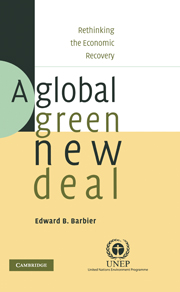Book contents
- Frontmatter
- Contents
- List of figures
- List of tables
- List of boxes
- Foreword
- Preface
- Acknowledgements
- Part I Why a Global Green New Deal?
- Part II The Key Components of a Global Green New Deal
- Part III The Role of the International Community
- Part IV Towards a Greener World Economy
- Appendix 1 PIIE–WRI analysis of a green recovery program for the United States
- Appendix 2 Pew comparative analysis of clean energy jobs and investments in the United States, 1998–2007
- Glossary
- Index
Part III - The Role of the International Community
Published online by Cambridge University Press: 05 June 2012
- Frontmatter
- Contents
- List of figures
- List of tables
- List of boxes
- Foreword
- Preface
- Acknowledgements
- Part I Why a Global Green New Deal?
- Part II The Key Components of a Global Green New Deal
- Part III The Role of the International Community
- Part IV Towards a Greener World Economy
- Appendix 1 PIIE–WRI analysis of a green recovery program for the United States
- Appendix 2 Pew comparative analysis of clean energy jobs and investments in the United States, 1998–2007
- Glossary
- Index
Summary
The various national actions proposed in part II are necessary components of the Global Green New Deal; but they are not sufficient.
To overcome the challenges facing developing economies will require additional actions by the international community. International cooperation and policy coordination across countries will also assist the effectiveness of the national actions described in part II. The purpose of part III is to suggest how the international community can facilitate the adoption of a GGND strategy by national governments and enhance the benefits gained from such policies in terms of stimulating economic recovery, generating jobs, reducing poverty and sustaining economic development.
Chapter 4, in part II, identifies a number of challenges facing developing countries in implementing the GGND. For example, there is a serious “capital gap” preventing developing economies from implementing the proposed national actions over the next one to two years. Equally constraining is the “skills and technology gap”; most developing economies, with the possible exceptions of Brazil, China, India, Russia and other large emerging market economies, do not have the research and development capacity or the skilled workforce to import and adapt the new skills and technology for many of the proposed investments. Both these gaps can be overcome by increased financing, but during the current global economic crisis new financial flows are in short supply. Potential aid flows from donors are likely to be reduced rather than increased. The crisis has unquestionably reduced private investment flows, especially to more risky investments with longer-term returns.
- Type
- Chapter
- Information
- A Global Green New DealRethinking the Economic Recovery, pp. 179 - 181Publisher: Cambridge University PressPrint publication year: 2010



